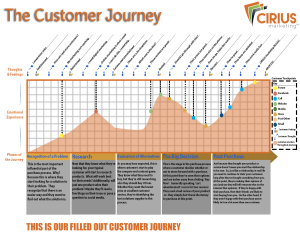Whether you realize it or not, the customer journey is already a part of your day at the office.
Every time you make contact with a customer, you’re recalling how they’ve interacted with your business. Are they a returning customer? Or an inquiring lead?
The customer journey is the living example of the purchase process.
Taking the time to map the customer journey will provide the confidence and momentum you need to leave every sale successful.
Why the Customer Journey is Vital for Sales Success
“Have you created your customer journey?”
For the majority of people the answer is ‘no’ and those who have one aren’t really sure why it’s so important. Despite what you think, a customer journey is necessary (even if you don’t have a website).
Think about like this:
How are you going to offer the optimal customer service experience at every point in your relationship with the customer?
The Harvard Business Review found that over the course of interactions with a customer, satisfaction fell over 40%.
Don’t you want to prevent that?
Not only will it help your sales team understand potential and current customers better, it will also become a vital resource for driving traffic (among other things) to your website. Once you have your customer journey mapped out, your sales team won’t struggle to figure out where a lead is in the purchase decision process. This is especially useful in optimizing the customer service experience because you’ll know exactly what to say (without repeating what they already know).
Still don’t believe mapping your customer journey is worth the time?
How to Use the Customer Journey Map
Before we dive into the process, let’s take a second to get familiar with the map:

Want a copy of the Customer Journey Map? [Download the template for FREE here.]
The thick grey bar that lines the bottom of the map displays different stages in the purchase decision process.
The left side of the map cites the experience through the purchase decision process. The white space above the grid is where thoughts of the customer should go.
(Example: We are moving, the price has to be right.)
The box on the right shows typical customer touchpoints.
The blank grid is your space to classify the touchpoint and write notes on the customer’s experience through each phase.
Feeling overwhelmed? If your small business doesn’t seem to be ready for this step, it’s time to consider a [strategy session] or [marketing plan].
Completing the Customer Journey Map
STEP 1:
With your team, make a list of every way your customers interact with you.
Examples of Customer Touchpoints
-Your Company Blog
-Customer Support Tickets
-Direct Store Visit
-Your Website
Once you’ve listed your customer touchpoints, gather the analytics from every platform you’re utilizing.
After careful review, you should be able to define with your sales team exactly where customers are in the purchase decision process (and where to place it on the map).
STEP 2:
While gathering touchpoints and analytics, it’s almost guaranteed that you’ve noticed a niche within your target market.
Relax, that’s why there’s space on the graph. Collect your notable thoughts and write them in the white space above the grid. This may take brainstorming a few lists with your team on why customers seek the product and where they are at in the purchase decision.
STEP 3:
Now that you’ve got everything you need in order and on your customer journey map. It’s time to define the interaction in the emotional experience.
Ask your sales team typical objections, inquire, and post-purchase questions that come with the product or service and coordinate them with a touch-point and stage in the purchase process.
Yes, it really is THAT simple.
Recommended Reading: Here’s Why You NEED a Customer Persona

 Important New Roles for Non-Profit Chief Marketing Officers
Important New Roles for Non-Profit Chief Marketing Officers Does Your Business REALLY Need Mobile App Marketing?
Does Your Business REALLY Need Mobile App Marketing? 13 Quotes to Get Small Business Owners Through the Day
13 Quotes to Get Small Business Owners Through the Day